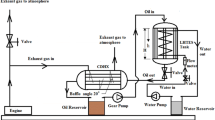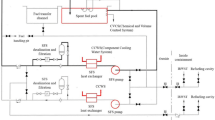Abstract
Due to the increase in energy requirements for various process industries and depletion of fossil fuel reservoirs, it is necessary to recover the heat energy which is exhausted to the environment from different sources. Effective utilization and recovery of waste heat is of great importance for the preservation of energy sources and protection of an environment and health hazards. For many industrial practices because of high effectiveness the application of Thermosyphon is increasing for the recovery of waste heat. The focus of the present study is to investigate theoretically the performance parameters (thermal and geometrical) of the Single tube wickless heat pipe heat exchanger (Thermosyphon) for heat recovery at simulated diesel engine exhaust conditions (Air temperature of ~150, 250 and 350 °C and under forced convective heating and cooling at different Reynolds number). From the theoretical analysis it was observed that effectiveness of Thermosyphon was over 50% for each of the conditions and it was increased up to 88% with decreasing inlet hot air velocity down to 1 m/s at temperature of 350 °C. It was also observed that at equal heat capacity rate of hot and cold fluids the effectiveness is minimum.














Similar content being viewed by others
Abbreviations
- Acso :
-
Outer surface area of condenser (m2)
- Acsi :
-
Inner surface area of condenser (m2)
- Aeso :
-
Outer surface area of Evaporator (m2)
- Aesi :
-
Inner surface area of Evaporator (m2)
- Cc :
-
Heat capacity of cold air ((kJ/ K)
- Ch :
-
Heat capacity of hot gas ((kJ/ K)
- Cp :
-
Specific heat at constant pressure (kJ/kg K)
- Cpg or Cpe :
-
Specific heat of gas (kJ/kg K)
- Cpc :
-
Specific heat of cold air (kJ/kg K)
- D:
-
Cylinder Bore Diameter (m)
- do :
-
Outer diameter of heat pipe (m)
- di :
-
Inner diameter of heat pipe (m)
- dt :
-
Tube diameter (m)
- Dseo :
-
Outer diameter of Evaporator Shell (m)
- Dsei :
-
Inner diameter of Evaporator Shell (m)
- Dsco :
-
Outer diameter of condenser Shell (m)
- Dsci :
-
Inner diameter of condenser Shell (m)
- Doc :
-
Outer diameter of insulation on condenser (m)
- Dh :
-
Hydraulic diameter (m)
- Dmax :
-
Maximum diameter of heat pipe (m)
- DE:
-
Diesel engine
- h:
-
heat transfer coefficient (W/m2K)
- hei :
-
Convective heat transfer coefficient inside the evaporator (W/m2K)
- heo :
-
Convective heat transfer coefficient outside the evaporator (W/m2K)
- hf :
-
Heating value
- hci :
-
Convective heat transfer coefficient inside the condenser(W/m2K)
- hco :
-
Convective heat transfer coefficient (W/m2K)
- h∞ :
-
Convective heat transfer coefficient of atmosphere (W/m2s)
- \( \overline{h} \) :
-
Average heat transfer coefficient(W/m2K)
- HP:
-
Horse power
- HPHE:
-
Heat pipe heat exchanger
- ID:
-
Internal diameter (m)
- kcu :
-
Thermal conductivity of copper (W/mK)
- kg :
-
Thermal conductivity of the gas(W/mK)
- Ks :
-
Thermal Conductivity of steel (w/mk)
- Lc :
-
Length of condenser (m)
- Le :
-
Length of evaporator (m)
- Lt :
-
Total length of Thermosyphon (m)
- L:
-
Stroke length (m)
- lpm:
-
Liters per minute
- ṁ:
-
Mass flow rate (kg/s)
- ṁca :
-
Mass flow rate of air (condenser) (kg/s)
- ṁe :
-
Mass flow rate (evaporator) (kg/s)
- ṁg :
-
Available Mass flow rate of gas ((kg/s)
- ṁs :
-
Mass flow rate of gas supplied ((kg/s)
- N or ne :
-
Revolution per minute (rpm)
- NTU:
-
Number of transfer unit
- Nu:
-
Nusselt number
- p:
-
Perimeter of a pipe (m)
- pi :
-
Pressure in the cylinder(N/m2)
- Pr:
-
Prandtl number
- Pve :
-
Vapour pressure in evaporator section (bar)
- Qavailable :
-
Heat available to heat pipe (W)
- Qe :
-
Inner power of the engine(W)
- Qf :
-
Power due to injected fuel(W)
- Qht :
-
Change in energy due to heat losses(W)
- Qsupplied :
-
Heat supplied to heat pipe (W)
- QRemoved :
-
Heat removed to heat pipe (W)
- Re:
-
Reynolds number
- Reg :
-
Gas Reynolds number
- S :
-
Allowable stress (N/m2)
- Ta or Tim :
-
Ambient air Temperature (°C)
- Tem :
-
Exhaust Manifold temperature of the Gas (K)
- Tcso :
-
Outer surface Temperature of Condenser (°C)
- Tcsi :
-
Inner surface Temperature of Condenser °C)
- Tco :
-
Temperature of Condenser outlet (°C)
- Tci :
-
Temperature of Condenser at inlet (°C)
- Tv :
-
Vapour temperature(°C)
- Teo :
-
Temperature of evaporator inlet (°C)
- Tei :
-
Temperature of evaporator at outlet (°C)
- Teso :
-
Outer surface Temperature of evaporator (°C)
- Tesi :
-
Inner surface Temperature of evaporator (°C)
- Tcso :
-
Outer surface Temperature of Condenser (°C)
- Tcsi :
-
Inner surface Temperature of Condenser (°C)
- Tco :
-
Cylinder outlet temperature
- Tgi :
-
Gas inlet temperature (°C)
- Tgo :
-
Gas outlet temperature (°C)
- Tm :
-
Gas mean temperature(°C)
- Tme :
-
Mean temperature of gas across the evaporator (K)
- Tmc :
-
Mean temperature of gas across the condenser (K)
- tmin :
-
Minimum thickness of Thermosyphon (m)
- Tsat :
-
Saturation Temperature (K)
- Tso :
-
Surface Outside Temperature (K)
- Tins :
-
Insulation Temperature (K)
- Tw :
-
Wall surface temperature(°C)
- uf :
-
Injected Quantity of Fuel (kg/s/cycle)
- Vact :
-
Actual swept volume (m3/s)
- Vd :
-
Displaced volume(m3/s)
- Vth :
-
theoretical swept volume (m3/s)
- Wf :
-
Total Fuel supplied (kg/s)
- Wg:
-
Gas mass velocity (kg/m2 s)
- Wco :
-
Gas mass flow rate (kg/s)
- ρg :
-
Density of hot gas (kg/m3)
- μg :
-
Viscosity of hot gas (Ns/m2)
- ɛt :
-
Overall effectiveness
- ɛC :
-
Effectiveness of Condenser section
- ɛe :
-
Effectiveness of Evaporator section
- ɛ:
-
Effectiveness
- ɛ-NTU:
-
Effectiveness-Number of transfer units
- η :
-
Efficiency
- ηvol :
-
Volumetric efficiency
- ϒv :
-
Ratio of specific heat for vapour
References
Pandiyarajan V, Pandian MC, Malan E, Velraj R, Seeniraj RV (2011) Experimental investigations on heat recovery from diesel engine exhaust using finned shell and tube heat exchanger and thermal storage system. Appl Energy 88:77–87
Hossain S (2013) BariS, waste heat recovery from the exhaust of a diesel generator using Rankine cycle. Energy Convers Manag 75:141–151
Wang T, Zhang Y, Peng Z, Shu G (2011) A review of researches on thermal exhaust heat recovery with Rankine cycle. Renew Sust Energ Rev 15:2862–2871
Re B J, Sturzebecher C, Bohn C, Marzke F, Frase R (2015) A diesel engine model including exhaust flap, intake throttle, LP-EGR and VGT. Part 1: system modelling. International Federation of Automatic Control (AFAC) 48(15):052–059
Wahlstrom J, Eriksson L (2010) Modelling of a diesel engine with intake throttle, VGT, and EGR. Tech. Rep. LiTH-R-2976, Department of Electrical Engineering, Linkoping University
Incropera FP, DeWitt DP (1996) Introduction to heatransfer, 3rd edn. Wiley, New York
Yang F, Yuan X, Linet G (2003) Waste heat recovery using heat pipe heat exchanger for heating automobile using exhaust gas. Appl Therm Eng 23:367–372
Faghri A (2014) Heat pipes: review, opportunities and challenges. Frontiers in Heat Pipes (FHP) 5:1–48
Yang C, Song C, Shang W, Taon P, Dengn T (2015) Flexible heat pipes with integrated bioinspired design. Progress in Natural Science Materials International 25:51–57
Jouhara Hand Meskimmon R (2014) Heat pipe based thermal management systems for energy-efficient data centres. Energy 77:265–270
Jouhara H, Meskimmon R (2010) Experimental investigation of wrap around loop heat pipe heat exchanger used in energy efficient air handling units. Energy 35:4592–4599
Yau Y, andAhmadzadehtalatapeh M (2010) A review on the application of horizontal heat pipe heat exchangers in air conditioning systems in the tropics. Appl Therm Eng 30:77–84
Jadhav T, Lele M (2015) Theoretical energy saving analysis of air conditioning system using heat pipe heat exchanger for Indian climatic zones. Int J Eng Sci Technol xxx:1–5
Wang Y, Han X, Liang Q, He W, Lang Z (2015) Experimental investigation of the thermal performance of a novel concentric condenser heat pipe array. Int J Heat Mass Transf 82:170–178
Srimuang W, Amatachaya P (2012) A review of the applications of heat pipe heat exchangers for heat recovery. Renew Sustain Energy Rev 16:4303–4315
Huang B, Tsuei J (1985) A method of analysis for heat pipe heat exchangers. Int J Heat Mass Transf 28:553–562
Lee Y, Bedrossian A (1978) The characteristics of heat exchangers using heat pipes or thermosyphon. Int J Heat Mass Transf 21:221–229
Noie SH (2006) Investigation of thermal performance of an air to air thermosyphon heat exchanger using (ε – NTU) method. Appl Therm Eng 26:559–567
Danielewicz J, Sayegh M, Sniechowska B, Szulgowska MZ, Jouhara H (2014) Experimental and analytical performance investigation of air to air two phase closed Thermosyphon based heat exchangers. Energy 77:82–87
Jouhara H, Merchant H (2012) Experimental investigation of a Thermosyphon based heat exchanger used in energy efficient air handling units. Energy 39:82–89
Han C, Zou L (2015) Study on the heat transfer characteristics of a moderate- temperature heat pipe heat exchanger. Int J Heat Mass Transf 91:302–310
Kumar V, Gangacharyulu D, Tathgir R (2007) Heat transfer studies of a heat pipe. Heat Transfer Engineering 28(11):954–965
Noie S, Majideian G (2000) Waste heat recovery using heat pipe heat exchanger (HPHE) for surgery rooms in hospital. Appl Therm Eng 20:1271–1282
Mostafa A, Mohamed M (2006) Heat pipe heat exchanger for heat recovery in air conditioning. Appl Therm Eng 2:659–668
Hagens H, Ganzevles F, Geld C, Grooten M (2007) Air heat exchangers with long heat pipes: experiments and predictions. Appl Therm Eng 27:2426–2434
Tan J, Liu C (1990) Predicting the performance of a heat pipe heat exchanger using the NTU method. Int J Heat Fluid Flow 11:376–379
Song L, John B, Ryan M (2005) Numerical study of heat pipe application in heat recovery systems. Appl Therm Eng 25:127–133
Kays and London (1984) Compact heat exchangers. McGraw-Hill, New York
Author information
Authors and Affiliations
Corresponding author
Ethics declarations
On behalf of all authors, the corresponding author states that there is no conflict of interest.
Additional information
Publisher’s note
Springer Nature remains neutral with regard to jurisdictional claims in published maps and institutional affiliations.
Rights and permissions
About this article
Cite this article
Yerne, Y.U., Bhusnoor, S.S. Theoretical thermal analysis of heat recovery by two phase closed Thermosyphon from engine exhaust. Heat Mass Transfer 55, 3211–3221 (2019). https://doi.org/10.1007/s00231-019-02641-x
Received:
Accepted:
Published:
Issue Date:
DOI: https://doi.org/10.1007/s00231-019-02641-x




